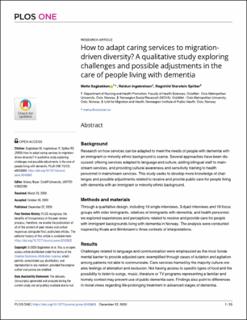| dc.contributor.author | Sagbakken, Mette | |
| dc.contributor.author | Ingebretsen, Reidun | |
| dc.contributor.author | Spilker, Ragnhild Storstein | |
| dc.coverage.spatial | Norway | en_US |
| dc.date.accessioned | 2021-06-11T12:25:28Z | |
| dc.date.available | 2021-06-11T12:25:28Z | |
| dc.date.created | 2020-11-27T01:38:45Z | |
| dc.date.issued | 2020-12-22 | |
| dc.identifier.citation | PLOS ONE. 2020, 15 (12), 1-25). | en_US |
| dc.identifier.issn | 1932-6203 | |
| dc.identifier.uri | https://hdl.handle.net/11250/2758997 | |
| dc.description.abstract | Background: Research on how services can be adapted to meet the needs of people with dementia with an immigrant or minority ethnic background is scarce. Several approaches have been dis- cussed: offering services adapted to language and culture, adding bilingual staff to main- stream services, and providing cultural awareness and sensitivity training to health personnel in mainstream services. This study seeks to develop more knowledge of chal- lenges and possible adjustments related to receive and provide public care for people living with dementia with an immigrant or minority ethnic background.
Methods and materials: Through a qualitative design, including 19 single interviews, 3 dyad interviews and 16 focus groups with older immigrants, relatives of immigrants with dementia, and health personnel, we explored experiences and perceptions related to receive and provide care for people with immigrant backgrounds living with dementia in Norway. The analysis were conducted inspired by Kvale and Brinkmann’s three contexts of interpretations.
Results: Challenges related to language and communication were emphasized as the most funda- mental barrier to provide adjusted care; exemplified through cases of isolation and agitation among patients not able to communicate. Care services framed by the majority culture cre- ates feelings of alienation and exclusion. Not having access to specific types of food and the possibility to listen to songs, music, literature or TV programs representing a familiar and homely context may prevent use of public dementia care. Findings also point to differences in moral views regarding life-prolonging treatment in advanced stages of dementia.
Conclusion: This study argues that to be able to address challenges related to migration-driven diversity one needs holistic care services that addresses individual as well as socio-cultural needs. A linguistically and culturally diverse workforce may represent an important resource, poten- tially reducing some of the problems related to communication. On a structural level, it seems necessary to allocate more time and resources, including the use of interpreters, when assessing and getting to know persons with dementia with another linguistic and cul- tural background. However, shared language does not guarantee understanding. Rather, one needs to become familiar with each person’s way of being ill, on a cultural and individual level, including changes occurring living with progressive dementia. Getting to know a per- son and his/her family will also facilitate the possibility to ensure a more familiar and homely context. Thus, continuity in relation to language and culture is important, but continuity in relations may be equally important ensuring that people with dementia receive equitable care. | en_US |
| dc.description.sponsorship | The study was supported by the Norwegian Directorate of Health. | en_US |
| dc.language.iso | eng | en_US |
| dc.publisher | Public Library of Science | en_US |
| dc.relation.ispartofseries | PLOS ONE;volume 15, issue 12 | |
| dc.rights | Navngivelse 4.0 Internasjonal | * |
| dc.rights.uri | http://creativecommons.org/licenses/by/4.0/deed.no | * |
| dc.subject | Caring services | en_US |
| dc.subject | Migration-driven diversity | en_US |
| dc.subject | Qualitative studies | en_US |
| dc.subject | Dementia | en_US |
| dc.title | How to adapt caring services to migration-driven diversity? A qualitative study exploring challenges and possible adjustments in the care of people living with dementia | en_US |
| dc.type | Peer reviewed | en_US |
| dc.type | Journal article | en_US |
| dc.description.version | publishedVersion | en_US |
| dc.rights.holder | © 2020 Sagbakken et al. | en_US |
| dc.source.articlenumber | e0243803 | en_US |
| cristin.ispublished | true | |
| cristin.fulltext | original | |
| cristin.qualitycode | 1 | |
| dc.identifier.doi | https://doi.org/10.1371/journal.pone.0243803 | |
| dc.identifier.cristin | 1853187 | |
| dc.source.journal | PLOS ONE | en_US |
| dc.source.volume | 15 | en_US |
| dc.source.issue | 12 | en_US |
| dc.source.pagenumber | 25 | en_US |

